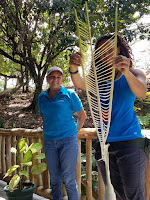(Wikipedia quote)
“The economic sector of tourism began to develop in the 1980’s and is now
the country’s main revenue source. Costa
As far as I could tell, most of our guides were Costa Rican as well as experts or specialists in their fields. Those who guided us through the traditional and indigenous areas generally came from indigenous backgrounds. The Government promotes and provides sponsorship for training as guides for the Tourism industry.
How the Pineapples
grow – our first field trip
In Europe , almost 75
percent of pineapples are imported from Costa Rica Costa Rica Nicaragua
Growing pineapple
(that only started in 1970) has generated considerable controversy in this
eco-friendly country because of the extensive pesticides, labour practices and
so on but we visited a certified organic plantation.
So what is Heart of Palm?
It is harvested from the inner core and growing buds of certain palm trees. The farm we visited actually cultivates the palm trees for the hearts – some types of Palms grow suckers that can be harvested but often the tree is cut down; the bark is removed; and the white fiber layer around the center core (the heart) is exposed for harvest.
As of 2008, Costa Rica U.S.
Dave’s
Natural Pavilion
Fascinating story
this . . . Actually Dave and Dave’s Natural Pavilion (founded initially by Dave
Sr.) was just down the road from the Sarapiqui Rainforest
Lodge we stayed at. I manage to talk to Dave Sr. He was from
Time and my energy got in the way of
exploring more of the Park but we were able to
observe some of the birds that come to Park (Thanks to Jim and CJ for letting me use their photos in the
BLOG).
Macaw Breeding Project
The Macaw Breeding site we
visited is part of the Macaw Recovery Network. A Program that breeds rescued
non-sustainable macaws and releases their young into the wild to help
repopulate the wilds with these beautiful members of the parrot family.
This particular
centre has become quite a Tourist attraction, complete with water buffalo.
Going to School!
Education has been
free and mandatory for all the citizens of Costa Rica
We visited a local
'model' school. Kids (around grade 5ish ) all cleaned and shiny escorted us around
and danced for us. Traveling with a bunch of North Carolina















































